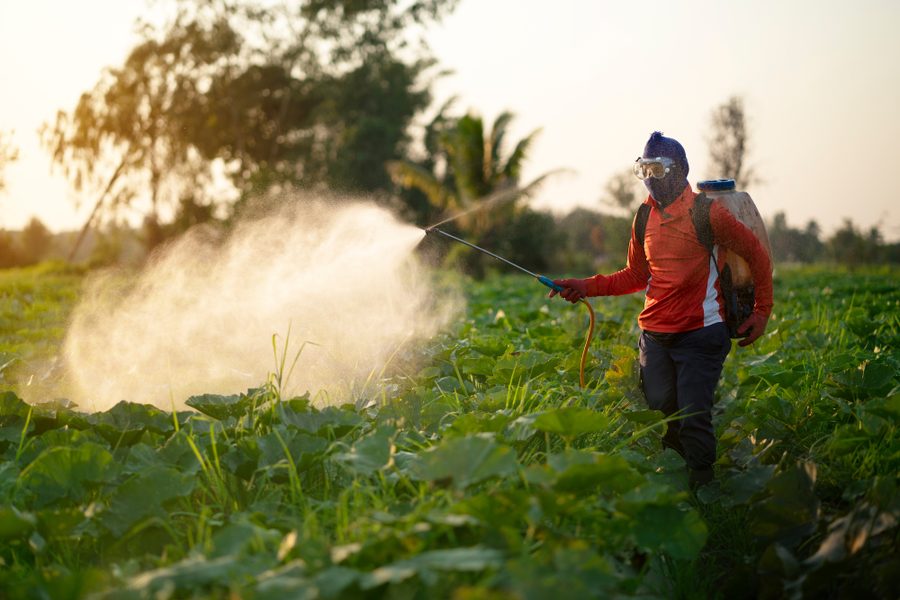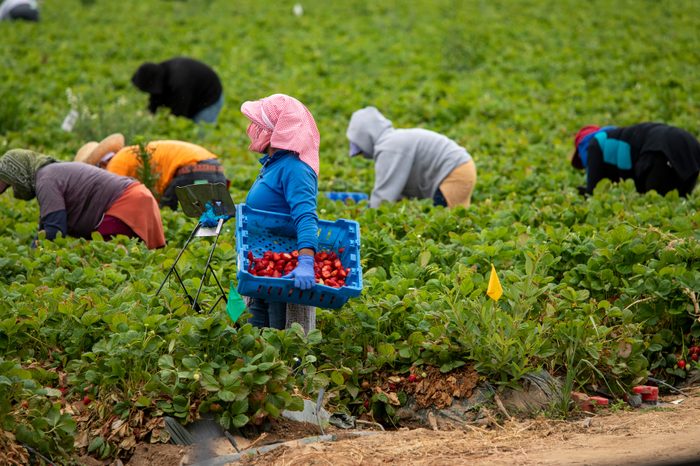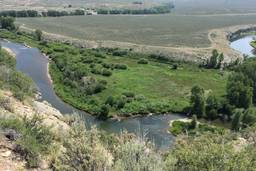It’s Too Hot to Keep Using Pesticides
Farm workers are being sickened by agrochemicals—and, due to extreme heat, by the PPE they wear to protect themselves.
Harrison Watson

It’s summer and time to take in the sunshine. But beware: because of climate change, the planet is rapidly warming. Outdoor temperatures are climbing above 100oF. Raging heat waves are causing debilitating illness and death. In some places, floods sweep through the streets. In others, precipitation is declining and water sources are evaporating. The Union of Concerned Scientists has dubbed this time of year, from May to October, the “danger season.”
Humans have not evolved to withstand such levels of heat stress. Still, over 2 million farm workers find themselves out in the fields. Some are suited up in heavy layers of clothing, including flannel shirts, pants, boots, gloves and coveralls. The purpose of this personal protective equipment (PPE) is to shield farm workers from the chemical threats they face from working with and around toxic pesticides and herbicides.
Each year, farmers and farm workers use billions of pounds of pesticides to suppress pests across 250 million acres of crop fields in the United States. The Environmental Protection Agency (EPA) does work to educate farm workers and help them navigate pesticide-treated fields safely. Still, according to the National Agricultural Worker Survey nearly one-third of all farm workers do not receive the annual, mandatory training.
“So some farm workers just don’t know how harmful pesticides are,” says Mayra Reiter, director of the Occupational Safety and Health division at the organization Farmworker Justice. “The EPA approves chemicals because they assume that farmworkers will wear PPE, but those farm workers aren’t wearing it.”
Every year, pesticides sicken 300,000 farm workers, according to the U.S. Government Accountability Office. No one has an accurate count of how many of them die.
And the PPE farmworkers need to protect them from these chemicals can’t protect them from the danger sealed therein: Wrapped tight in their PPE, the heat they generate working at a feverish pace has nowhere to dissipate. In some places, a third of farm workers out in the fields suffer from heat-related illnesses every year.
This is because many farm workers are constrained by the current wage system to ignore workplace hazards or skip water, bathroom and cooling breaks. In several states, farm workers receive “piece-rate” wages — that is, instead of an hourly wage, they’re paid by the bucket, bushel or piece of crop they pick.
“But even if they receive an hourly wage their bosses still don’t give them a chance to take a break,” says Reiter. “Their bosses tell them they’re paid to work by the hour, not stand in the shade. In the end they have to balance keeping cool in extreme heat with protecting themselves from hazardous pesticides.”
This contradiction points to a difficult truth of our changing world: It’s simply too hot outside to keep using pesticides. The workers who pick the produce we pile on our plates should not have to choose between productivity and their health. An agricultural system that forces farm workers into such a choice is neither sustainable nor just. In its place, we need an overhauled food system that protects not only crops, but the soils they grow from, the other plants and creatures that live amongst them, and the workers who tend them.

Right now, as farm workers confront the hazards of pesticides in the heat of the “danger season,” the Farm Bill is being negotiated on Capitol Hill. This bill will become the law that governs the food we eat, how it is grown, and who grows it for the next five years and potentially beyond. Thus, it is key to achieving the new food system both people and the environment need. But, so far, food availability and commodity insurances have been the central focus of deliberation, and for good reason: during the danger season, our crops suffer too. As temperatures rise and precipitation declines, they become more vulnerable to diseases, pests, and heat stress.
But lawmakers need to add protections for workers as well. A federally enforced minimum wage and overtime pay would be a good place to start. Farm workers and their families also need access to health insurance and multi-lingual healthcare facilities in close proximity. The Occupational Safety and Health Administration needs increased funding to support research and development around climate-appropriate PPE.
Farm workers deserve better protections under the law, but the EPA also needs to step in to lead research and enforce tighter regulations on pesticides. If no changes are made to current standards, greater amounts of liquid-based pesticides will need to be applied to replace what the heat deteriorates or evaporates away. As one solution to protect farmers and farm workers, pesticide-treated seeds were introduced as an alternative to spraying in the 1990s. For neurotoxic (neonicotinoid) insecticides, treated seeds are used in at least 90% of commodity crops today. For wild pollinators, however, these treated seeds are a death sentence. Insect populations are declining across farmlands, and birds are starving without these species. A single treated seed carries enough poison to kill a songbird or 80,000 bees. Unfortunately, birds are likely to feel the effects of acute neurotoxic poisoning long before they learn to avoid coated seeds. But with dwindling insect populations, they often have no other food choices.
Ultimately, we need a regenerative, decentralized and diversified food system. Currently, only a small, predominantly white group of people own much of America’s farmland. Many of these owners are aging out of farming. Because the profit margins are so slim in the agricultural industry, only a smaller group still can afford to buy the land. And even for these select few, it’s currently too costly to practice pesticide-free organic agriculture over many acres of farmland.
It’s time for the USDA to step up and lead a transition away from large industrial agriculture towards more affordable, small, regenerative farms. Fortunately, the programs to make this transition possible already exist. With the Federal Crop Insurance and Conservation Stewardship Program, the USDA can restructure our current food system to embody an agroecological framework that prioritizes human, soil and wildlife health and production equally.
Such a fundamental shift in our approach to the way we grow our food will not occur overnight. Our food system needs more funding to support young aspiring farmers from historically disadvantaged groups — from Black and Indigenous communities to descendants of the migrant farmworkers out in the fields today.
Climate change and extreme heat have revealed a fundamental flaw in our food system. It’s not the kind of problem that can simply be patched up or sprayed away. Amid this extreme heat, it’s time to take a step back and think about how we can build a just approach to food production that protects all involved.
Harrison Watson is a Ph.D. student in ecology at Princeton University. He is also a Public Voices Fellow of the Op-Ed Project and Yale Program for Climate Change Communication and a Conservation and Justice Fellow with the American Bird Conservancy.




